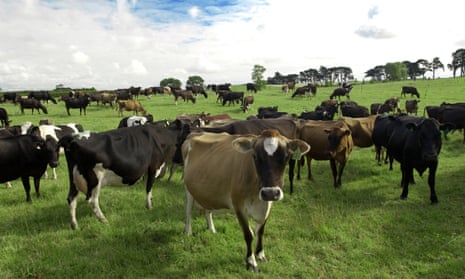Greenhouse gases released by New Zealand’s dairy industry have hit an all-time high, according to the latest data.
Data from Stats NZ, just released for the years 2007-2019, showed dairy emissions rose 3.18% in 2019, to a total of 17,719 kilotonnes of carbon dioxide equivalent that year. That rise helped drive an overall increase across the agricultural sector, which released almost 42,000 kilotonnes that year.
Agriculture made up more than half of the total industry and household emissions measured by Stats NZ, with most of that split between dairy, sheep and beef farming. Theincrease continued a longer-term rise in emissions from New Zealand agriculture, where emissions were up 5.5% in the past decade.
The emissions created by the digestive systems of New Zealand’s 6.3m cows are among New Zealand’s biggest environmental problems. Agriculture is one of the country’s biggest producers of the greenhouse gases that cause global heating and the climate crisis.
Greenpeace spokesperson Steve Abel said it was “no surprise that when you let corporations and industries regulate themselves, they basically maintain the status quo of their pollution profile”.
“You have to step in and regulate and legislate to lower greenhouse gas emissions,” he said.
New Zealand is one of the world’s worst performers on emission increases. Its emissions rose by 57% between 1990 and 2018 – the second greatest increase of all industrialised countries. Earlier this year, data showed that New Zealand’s emissions had increased by 2% in 2018-19.
The president of Federated Farmers, Andrew Hoggard, said: “Food isn’t a nice-to-have, it’s a must-have, and New Zealand farmers are amongst the best in the world at producing food in a very low footprint.”
“For New Zealand to go off on some virtue signalling crusade to shut down its agricultural sector, just to say ‘Hey, we’ve reduced a heap of emissions’ hasn’t solved anything,” he added.
The sector is hopeful that new scientific developments, such as methane inhibitors, breeding, and using different forms of feed would continue to reduce methane emissions, Hoggard said.
In 2019, New Zealand passed multipartisan climate legislation setting a net zero by 2050 target for CO2 emissions, and set up the Climate Change Commission to map out a pathway there. The government is legally bound to formulate a policy response to the commission’s report, which was released in June – but has not outlined what those policy steps will be. The commission’s report found that some of the work to reduce methane emissions could be done through improved farm practices and breeding animals that produced less gas – but it would also require a drop in the number of total herd numbers by 10%-15%.
Hoggard also said methane emissions were down from 2006 – although data shows methane emissions spiked particularly high that year. Methane emissions since 2008 have been trending mostly up.
Abel said Thursday’s data release should be considered a conservative estimate, because it did not include emissions from transport, coal used to dehydrate milk powder, or the emissions of palm kernel imported for food.
“All of the promises of the dairy industry that it will self regulate and take charge of the problem are clearly not working, and that is borne out by the actual emissions data,” Abel said.
“We need farming, but farming needs to stop being this industrial polluter – it needs to move to making the land healthy, keeping our rivers healthy, keeping our fresh water healthy and not driving extreme weather events through climate change.”
